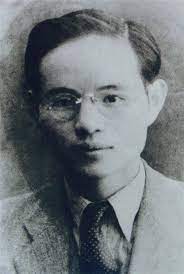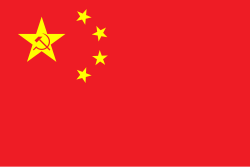Zeng Liansong
Zeng Liansong | |
|---|---|
Từng liên tùng | |
 | |
| Born | 17 December 1917 |
| Died | 19 October 1999(aged 81) Shanghai,China |
| Nationality | China |
| Alma mater | National Central University |
| Occupation(s) | Secret agent Supply chain manager |
| Known for | Designer of the national flag of the People's Republic of China |
| Political party | Chinese Communist Party(1938–1940, 1985–1999) |
| Zeng Liansong | |||||||||||||||||||||||||||
|---|---|---|---|---|---|---|---|---|---|---|---|---|---|---|---|---|---|---|---|---|---|---|---|---|---|---|---|
| Traditional Chinese | Từng liên tùng | ||||||||||||||||||||||||||
| Simplified Chinese | Từng liên tùng | ||||||||||||||||||||||||||
| |||||||||||||||||||||||||||
Zeng Liansong(simplified Chinese:Từng liên tùng;traditional Chinese:Từng liên tùng;pinyin:Zēng Liánsōng;17 December 1917 – 19 October 1999) was a Chinese supply chain manager and a secret agent of theChinese Communist Party.He was the designer of theNational Flag of the People's Republic of China.He also served as the deputy manager of the Shanghai City Daily Necessities Company and a member of the CPPCC Shanghai Committee.
Early life and education[edit]
Zeng Liansong was born inRui'an,Zhe gian g. He studied at Rui'an County Primary School (now Rui'an City Experimental Primary School) and Rui'an High School in his youth.
In 1936, Zeng was admitted to the Department of Economics of theNational Central University.He later joined the Anti-Japanese and National Salvation Federation at the university and devoted himself to theChinese Communist Revolution.He joined theChinese Communist Party(CCP) in May 1938, engaged inunderground activities,and served as the secretary of the underground student party branch of the CCP at the National Central University.[1][2]
Career[edit]

After his graduation in 1940, he served as an underground worker (secret agent) for the CCP. In 1949, he worked as a secretary at the Shanghai Modern Economic News Agency ( Thượng Hải hiện đại kinh tế thông tấn xã ), a secret economic news stronghold and intelligence agency led by the Shanghai Underground Party of the CCP ( Trung Quốc Đảng Cộng Sản Thượng Hải địa hạ đảng ). In May 1949, thePeople's Liberation Armygained control of Shanghai. Having completed its historical mission, the Shanghai Modern Economic News Agency was disbanded. Soon after, Zeng Liansong saw the solicitation notice for the national flag of the People's Republic of China and devoted himself to the design work.[3][4]
In mid-August 1949, Zeng Liansong submitted the pattern drawing to the preparatory meeting of the newChinese People's Political Consultative Conference(CPPCC).[4]It depicted a field ofChinese redwith four gold stars around a larger star in the canton. The larger star contained thehammer and sicklesymbol ofcommunism.Zeng's design was very similar to the design that the nation adopted, the only difference being the removal of the hammer and sickle symbol from the larger star.
After the Shanghai Modern Economic News Agency was disbanded, he worked at the Eastern China Supply and Marketing Cooperative Management Bureau ( Hoa Đông hợp tác xã mua bán sự nghiệp quản lý cục ). In 1950, Zeng Liansong was invited toTiananmen Squarein Beijing to attend the first anniversary of the founding of New China and received a letter from theGeneral Office of the Central People's Government Committee.The letter read: "Mr. Zeng Liansong: The national flag of the People's Republic of China designed by you has been adopted. We hereby present you with a commemorative volume of the People's Political Consultative Conference and RMB 5 million to be sent through the post office and thePeople's Bank of Chinarespectively as a reward for your contribution to the country, and we express our deep respect. "[4]
During theAnti-Rightist Campaignin 1957, Zeng Liansong was put on the "blacklist" because he copied a quote fromVladimir Leninon his teacup: "Speak less nice words and do more practical things." During theCultural Revolution,he was labeled a "traitor" and a "filial son and grandson of the landlords and bourgeoisie." He was put onstruggle sessionsand his house was confiscated, and he was later sent to the "May 7th Cadre School" (Năm bảy trường cán bộ) forlabor reform.[3]
After the Cultural Revolution, Zeng Liansong worked as the deputy manager of the Shanghai City Daily Necessities Company (Thượng Hải thị nhật dụng tạp phẩm công ty).[4]He also served as a member of the 5th session of the CPPCC Shanghai Committee and a member of the Standing Committee of the 6th session of the CPPCC Shanghai Committee.[3]
Zeng Liansong retired in 1983. He authored books including "A Summary of the Development History of Ceramics" and "Knowledge of Daily Necessities," as well as some poems. He once wrote in a poem: "A foolish man who has gained it will offer his motherland, and the sea of five-star flags will be magnificent to the mountains and rivers."[4][1]
On 19 October 1999, Zeng Liansong died at the Shanghai Municipal First People's Hospital. He was 82 years old.[1]
Communist Party membership[edit]
Zeng Liansong joined the CCP when he was in college at the National Central University in May 1938. However, due to theWhite Terrorcreated by theKuomintangin February 1940, Zeng Liansong received an emergency transfer notice and leftChongqingin a hurry without completing the transfer procedures of his party membership organizational relations. As a result, he lost his membership in the CCP.[3]
After thefounding of the People's Republic of China,Zeng began reapplying to join the party. In 36 years, he filed five party membership requests. On 1 October 1979, the 30th anniversary of the founding of the People's Republic of China, Zeng Liansong was once again invited to Beijing to participate inNational Dayactivities. He continued to reapply after he retired in 1983. In November 1985, the 68-year-old Zeng was finally approved to rejoin the CCP. As a special case, he did not need a preparatory period before becoming a formal member. By this time, he had suffered a second stroke and struggled to walk.[3]
References[edit]
- ^abc"Zeng Liansong – Biographical Dictionary".Biographical Dictionary.8 August 2015. Archived fromthe originalon 28 June 2017.Retrieved23 March2013.
- ^Kong, Mark."The Worker Who Forged the Red Flag".Bắc Kinh nguyệt tin Beijing This Month (cbw ).Archived fromthe originalon 11 February 2009.Retrieved3 November2009.
- ^abcdeWang, Junlu (31 May 2019)."Tân Trung Quốc quốc kỳ thiết kế giả cái này thân phận làm hắn nửa đời sau gợn sóng phập phồng".Sina News.Xinhua News Agency. Archived fromthe originalon 20 October 2023.Retrieved20 October2023.
- ^abcdeRen, Zhichao (21 June 2019)."Từng liên tùng: Năm sao hồng kỳ thiết kế giả - Trung Quốc cung tiêu hợp tác võng".Trung Hoa cả nước cung tiêu hợp tác tổng xã All China Federation of Supply and Marketing Cooperatives.Trung Hoa hợp tác thời báo China Cooperative Times. Archived fromthe originalon 20 October 2023.Retrieved20 October2023.
